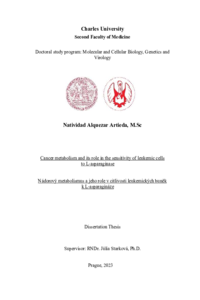Cancer metabolism and its role in the sensitivity to ASNase of leukemic cells to L-asparaginase
Nádorový metabolismus a jeho role v citlivosti leukemických buněk k L-asparagináze
dissertation thesis (DEFENDED)

View/
Permanent link
http://hdl.handle.net/20.500.11956/186148Identifiers
Study Information System: 184881
CU Caralogue: 9925868254206986
Collections
- Kvalifikační práce [1803]
Author
Advisor
Referee
Procházka, Vít
Truksa, Jaroslav
Faculty / Institute
Second Faculty of Medicine
Discipline
Molecular and Cellular Biology, Genetics and Virology
Department
Department of Paediatric Haematology and Oncology
Date of defense
12. 9. 2023
Publisher
Univerzita Karlova, 2. lékařská fakultaLanguage
English
Grade
Pass
Keywords (English)
Asparagine, PI3K, Akt pathway, cellular metabolism, childhood acute lymphoblastic leukemia, glutamine, l-asparaginase, mesenchymal stromal cells, metabolic profile, mTOR signaling pathwayCancer metabolism and its role in the sensitivity of leukemic cells to L- asparaginase ABSTRACT No ultimate treatment strategy exists for relapsed or non-responsive (15-20%) children with acute lymphoblastic leukemia (ALL). In this study, we aimed to elucidate the impact of metabolic rewiring in leukemic cells on poor therapy response and the emergence of resistance. This dissertation focuses on l-asparaginase (ASNase), a crucial chemotherapeutic agent and its effect on leukemia, using models of leukemic cell lines and primary cells of ALL patients. Cell metabolism was assessed by measuring metabolic pathways and nutrient influx using a Seahorse analyzer and stable isotope tracing. Main findings of the study demonstrated that the ASNase- therapy response was mitigated by the activity of the mechanistic target of rapamycin (mTOR)- regulated biosynthetic pathways. This phenomenon was induced by the bone marrow environment, which enabled the activation of the resistant mechanism in leukemic cells. We next found a correlation between the following metabolic features and lower sensitivity to ASNase: low ATP- linked respiration, high mitochondrial membrane potential and high glycolytic flux before therapy. The latter was shown to have prognostic implications. Moreover, high glycolytic flux was detected in T-ALL...
